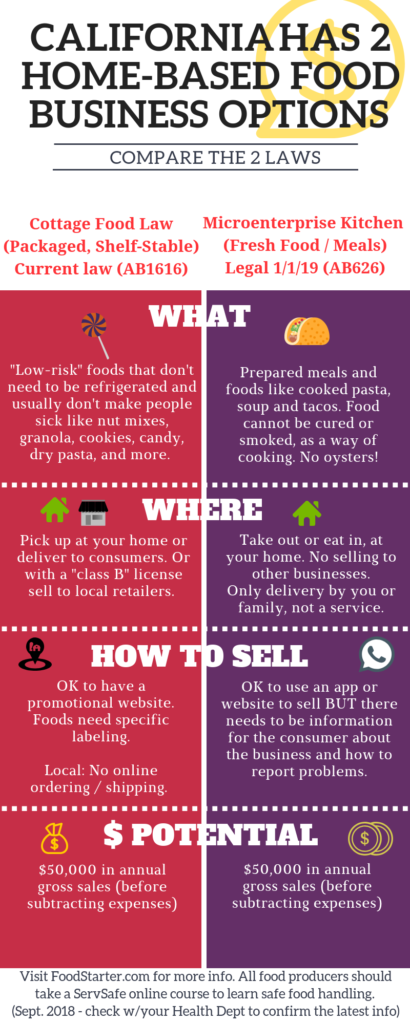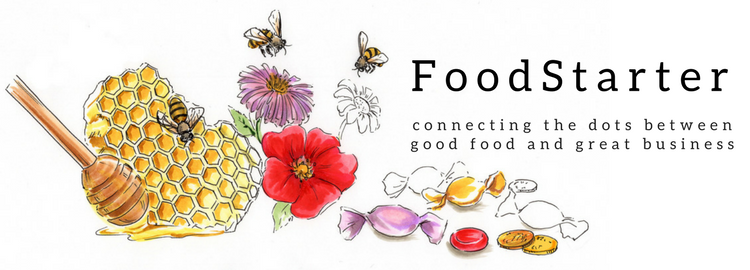As of January 1, 2019 home chefs in California can legally make and sell meals at home to neighbors as “microenterprise home kitchen operations”—provided that your county opts in to participate in this law.
This law is different from theCalifornia Homemade Cottage Food Law which licenses home chefs to produce packaged, shelf-stable foods.
Make this law happen in your area: Visit CookAlliance for info on how you can advocate for your county to support the law.
Please contact me if you’d like to add info, make corrections or discuss this for any reason.
How California’s Microenterprise Homemade Food Law Works
For all the details about the law, see Assembly Bill AB 626. I’ve tried to simplify the rules here. Your local health department / county has the option to NOT participate in the law.
Your county’s health department should have all of the specifics and process if you can apply when the state law goes into effect Jan. 2019 (or who you need to contact to advocate for your county to support this law, if need be):
What is a Microenterprise Home Kitchen Operation?
IMPORTANT: Home-based food businesses may be visited by enforcement officials if there are complaints or if you are getting licensed to sell packaged / cottage food to retailers. If you NEVER want this to happen, you may not want to operate a home-based meal business. You’ll find more info about this at the bottom of this article.
The Microenterprise Home Kitchen Operation must meet all of the following requirements:
A microenterprise home kitchen operation shall not be open for business unless it has obtained a permit issued from the local enforcement agency.
HACCP plans are plans that restaurants and food production facilities have to ensure safe food production and processes to fix any potentially or actually dangerous problems in sanitation or food preparation.
Which food and food preparation methods are NOT allowed?
Based on the above rule, the following food preparation / cooking methods are now allowed by Microenterprise kitchen businesses. (Here are the full rules from California’s Section 114419.)
(1) Smoking food is not allowed as a method of food preservation rather than as a method of flavor enhancement.
(2) Curing food is not allowed.
(3) Using food additives or adding components such as vinegar as a method of food preservation rather than as a method of flavor enhancement, or to render a food so that it is not potentially hazardous is not allowed.
(4) Operating a molluscan shellfish life support system display tank used to store and display shellfish that are offered for human consumption is not allowed.
(5) Custom processing animals that are for personal use as food and not for sale or service in a food facility is not allowed.
(6) Preparing food by another method that is determined by the enforcement agency to require an HACCP plan is not allowed.
ALSO – NO OYSTERS! (5) The service and sale of raw oysters is prohibited.
Limit to the number of daily meals. (6) Food preparation is limited to no more than 30 individual meals per day, or the approximate equivalent of meal components when sold separately, and no more than 60 individual meals, or the approximate equivalent of meal components when sold separately, per week.
The local enforcement agency may decrease the limit of the number of individual meals prepared based on food preparation capacity of the operation, but shall not, in any case, increase the limit of the number of individual meals prepared.
(b) “Microenterprise home kitchen operation” does not include either of the following:
(1) A catering operation.(2) A cottage food operation, as defined in Section 113758. (That’s another law.)
Who approves the kitchens to operate?
The bill says that the governing body of a city or county, or city and county, shall have full discretion to authorize, by ordinance or resolution, the permitting of microenterprise home kitchen operations in accordance with the provisions of this bill, except as provided.
How you can promote and sell to consumers
You will get in trouble if your food buyers complain or have problems.
Does my home-based food business and kitchen need to follow the same rules as restaurants?
Can I sell cookies, candy, churros and granola by following this law?
How will the Microenterprise Home Kitchen food business application process work?
Section 114367.2. says:
(a) A microenterprise home kitchen operation shall not be open for business unless it has obtained a permit issued from the local enforcement agency.
How to make customers happy and avoid complaints and inspections
Section 114367.3 is all about consumer complaints that may trigger inspections.
PRO TIP: Every home food business entrepreneur should take an online ServSafe safe food handling course. It is cheap and even if you have been cooking for 50 years, I guarantee you will learn something important. You will sell more by giving your customers confidence about your professionalism!
(a) Notwithstanding any other law, after the initial inspection for purposes of determining compliance with this chapter, a microenterprise home kitchen operation shall not be subject to routine inspections, except that a representative of a local enforcement agency may access, for inspection purposes, the permitted area of a microenterprise home kitchen operation after the occurrence of either of the following:
What signage and events can I have? Not much… you need to keep your residential neighbors happy.
Section 114367.4 is about keeping neighbors happy.
(a) (1) A city, county, or city and county shall not prohibit the operation of, require a permit to operate, require a rezone of the property for, or levy any fees on, or impose any other restriction on, a microenterprise home kitchen operation in any residential dwelling for zoning purposes.
A microenterprise home kitchen operation shall be a permitted use of residential property in any residential dwelling for zoning purposes if the microenterprise home kitchen operation complies with both of the following criteria:
What food delivery is allowed?
Section 114367.5. says:
Only employees, family members or roommates can deliver. (a) A person delivering food on behalf of a microenterprise home kitchen operation with a permit issued pursuant to Section 114367.2 shall be an employee of the operation or a family member or household member of the permitholder, and, if the person drives a motor vehicle in the delivery of the food, the person shall have a valid driver’s license.
How do I choose which app or website to promote and sell my homemade meals on?
Step 1: Be smart and safe.
Especially if you are directly paying the app or website — rather than having people pay you through Venmo or Square, which are perfectly fine ways for you to be paid as long as you track your sales — be sure they are following the law.
There may be people who try to take advantage of new home chefs, and you don’t want to be one of those!
The rules “Internet food service intermediaries” must follow
Section 114367.6. outlines the rules for Internet food service intermediaries which is important to read if you are going to list your business on an app or website that derives revenues from advertising or takes a fee from food sales.
- allowing a microenterprise home kitchen operation to advertise its food for sale and
- providing a means for potential consumers to arrange payment for the food, whether the consumer pays directly to the microenterprise home kitchen operation or to the Internet food service intermediary.
I have summarized the information that a homemade food business should know; if you are starting a business to help Microenterprise Kitchen Operators sell through your platform, read all the rules directly on the AB626 website.
An Internet food service intermediary that lists or promotes a microenterprise home kitchen operation on its Internet Web site or mobile application shall meet all of the following requirements:
Provide info on insurance coverage. They must cearly and conspicuously post on its Internet Web site or mobile application whether or not it has liability insurance that would cover any incidence arising from the sale or consumption of food listed or promoted on its Internet Web site or mobile application.
(If they don’t have insurance, you might want to get your own insurance.)
Enforcement officials can visit your home kitchen operation to determine compliance issues.
SEC. 7. Section 114390 of the Health and Safety Code reads:
RESOURCES TO GET STARTED
The law is not in effect until January 1, 2019. Before then, work on your planning. Copy and paste these questions into another document to use for your planning:
- What food are you great at making that qualifies as legal and that your neighbors will buy from you?
- Figure out how much you can charge and if you can make a profit. Remember the less ingredients cost, the more profit you will make. Shopping at Costco or at Amazon (through the ad below) is the best way to get bulk discounts. Sprouts Farmers Market also has great bulk prices.
- Get ServSafe certification. You need to have a very clean kitchen with clean and cold food storage to avoid any problems.
- Read the permitting laws, above, to make sure your home and kitchen quality and to help you figure out what your expenses will be.
Please send me updates and corrections.
Please share this with Spanish speaking home chef friends:
Cómo iniciar legalmente un negocio de comidas caseras en California
Traduzca a Español las reglas para fabricar y vender alimentos / comidas frescas como los tamales y enchiladas desde su hogar, a partir del 2019 en California con Google Translate.







